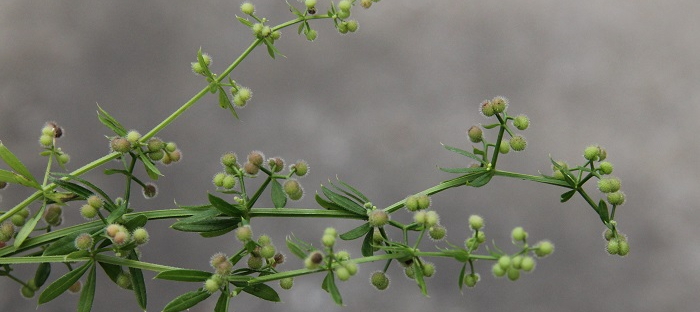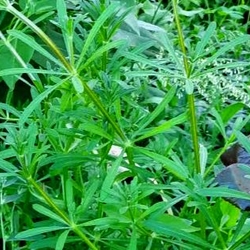(Editor's Note: This article was originally published on May 4, 2010. Your comments are welcome, but please be aware that authors of previously published articles may not be able to promptly respond to new questions or comments.)
You can call them what you want, goose grass, catchweed, or you could call them roses, but they would still be cleavers. They haunted me then and they are going to be the death of me today. Cleavers are those long, skinny, slightly vining plants that hide in thickets, in woods, in hedgerows, and among my daylily beds. When in all innocence I walk through my daylily gardens, without warning they leap out of their hiding place and they plant a low tackle around my feet and legs, the likes of which even Earl Campbell could not escape. I promise myself at the end of every blooming season that I will have yanked every single cell of cleavers out of my garden. But as soon as my daylilies appear, I forget my best laid plans of last summer and start winding my way through them. The lurking cleavers pounce and the daylilies and I have our first close encounter. It never fails. It is a springtime ritual, my face plant into the daylilies.
My first encounter with cleavers happened at a very young age. I remember it well. I went with my great Aunt Bett up in the mountains in search of them. I didn't really know what I was looking for, I was just following along with Aunt Bett when I fell flat on my face. She picked me up and with her pristine handkerchief that lived in her apron pocket, she wiped away the tears and the dirt. "I knew if I brought you with me, you would help me find them cleavers, chile, you done good!" A cleavers magnet, that's what I am, and always have been.
Cleavers, Galium aparine, is the most aggravating plant I have ever met. It is a weak-stemmed sprawling annual that forms dense, prickly mats over nearby plants and around their bases. The square bristly stem, one to five feet long, bears whorls of prickly lance shaped leaves. Small white flowers bloom in May and June, and even they produce tiny bristled fruits about an eighth of an inch across.
As a member of the madder family, cleavers is a relative of coffee. Cleavers seeds, lightly roasted, make a caffeine-free coffee substitute. Today's herbalists, as well as those of the past, have claimed medicinal virtues for the plant, too. They even prescribe a tea made from the entire plant for kidney stones and bladder problems. Used as a wash or a lotion the tea is said to fade freckles and sunburn as well as treat psoriasis. It's a funny thing, in researching I can't find a thing bad about the plant, and Aunt Bett used it for lotions and salves, but I am telling you, that plant is out to get me. It isn't that I ever did anything to make it want to retaliate. I never drank it for coffee, certainly not when I had plenty of chicory. I have never taken it to relieve kidney or bladder problms, and I have never in my life had a freckle or a sunburn. I simply don't know why it reaches out and trips me more than once every single summer.
Aunt Bett dried and powdered the roots too, because she said that sprinkling cleavers powder on bleeding wounds would make the blood clot and promote healing. Old time herbalists concocted a soup consisting of cleavers, mutton and sometimes oatmeal as an aid to dieting, perhaps because it was also believed to be a powerful diuretic. The shoots, rich in vitamin C were once given as a spring tonic and a cure for scurvy. Not once did even one drop of that stuff ever touch my tongue. They just simply like to cling to me. Mom used to say I was a magnet for mishaps, but I know better. I was a magnet for cleavers.

Cleavers is a native of Eurasia and North America, and it grows throughout the United States, and most abundantly in my yard. If I ever moved to the tundra of Alaska, cleavers would follow me there. Modern herbalists know it as a remedy for Vitamin C deficiency, as well as for urinary and bladder problems. However, research hasn't substantiated its value for the remedy of anything. Dried, the plant is still used as a tea in some parts of the world. The cooked shoots and young plants make a nourishing vegetable dish.
The only thing positive I can remember about the cleavers, is that its root makes a great red dye. For the life of me I see no other purpose for it. For about ten years I suddenly realized I had rid myself of cleavers here at my home in western Kentucky. In fact they never entered my garden or my mind at any time during the 90's. Early in the first years of 2000, however, I began transplanting one of every kind of plant my uncle had on his farm in Bardstown into my garden. I cleaned all the roots, all the bulbs, all the seeds, they were the cleanest plants ever in the history of transplantation. Pristine. Unfortunately, the cleavers clung to something and began to rear their ugly heads around my daylilies, which brings me to today.
They lurk, and in early summer they watch for me with my morning coffee in hand, wandering around among my lucious newly blooming daylilies. While I stand in admiration and awe beside the first gorgeous bloom, they carefully wind their way around my ankles and adhere themselves to my bare feet and between my coral polished toes. Smiling with the satisfaction of a new bloom, a new season, a beautiful world, I take one small step forward and find my coffee moistening the roots of the daylilies, and my first kiss of the morning on the base of their stems.
Whatta life!
Photos are from Plant Files.
In case you have forgotten, Earl Campbell was a quarterback for the Oilers in the 70's, an untackle-able quarterback, who is now in the Hall of Fame. I guess he never met up with cleavers.

















